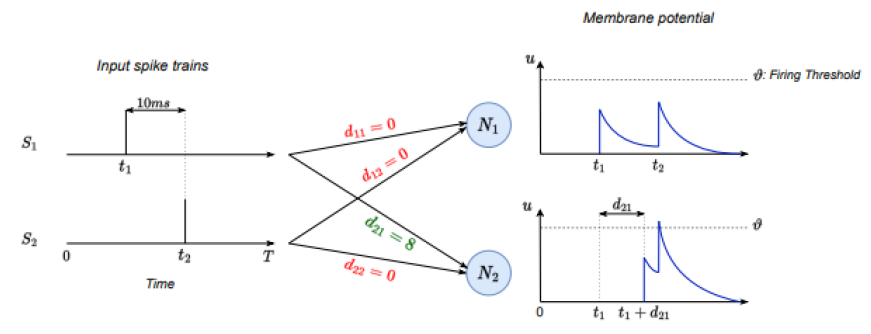Project Overview
This was a one-week project exploring Spiking Neural Networks (SNNs)—a bio-inspired neural network paradigm that mimics the behavior of biological neurons. The work was conducted in collaboration with Timothée Masquelier, one of the most cited researchers on SNNs. Unlike traditional artificial neural networks (ANNs) that instantly process continuous values, SNNs transmit information via discrete spikes, capturing not only input magnitude but also precise timing.
We focused on understanding how SNNs work, their unique learning mechanisms, and how to implement them for image and time series tasks.

How Spiking Neural Networks Work
From biological inspiration to the LIF model
SNNs are inspired by the brain, where neurons communicate through action potentials (spikes). A neuron integrates incoming signals from other neurons until its membrane potential exceeds a threshold, at which point it fires a spike. This spike travels along the axon, possibly with delays controlled by myelin insulation, and influences downstream neurons.
The Leaky Integrate-and-Fire (LIF) neuron is a simplified model of a biological neuron:
- Integration: Incoming spikes increase the neuron’s membrane potential.
- Leakage: The potential decays over time, mimicking natural membrane leakage.
- Firing: When the potential exceeds a threshold, the neuron emits a spike and resets.
This model captures essential neuronal dynamics while remaining computationally feasible. It allows SNNs to process temporal information in a way that traditional ANNs cannot.
Learning in SNNs
Training SNNs poses unique challenges due to the non-differentiable spike function. Standard backpropagation cannot compute gradients through discrete spikes. Two key solutions are used:
- Surrogate Gradient Learning: Replaces the non-differentiable spike function with a smooth approximation (e.g., a sigmoid) during gradient computation, allowing standard gradient-based optimization.
- Delay Learning: Synaptic delays between neurons can be learned during training, enabling the network to capture precise temporal relationships in data. Delays are represented as Gaussian kernel convolutions whose mean shifts during training, effectively shaping the spike timing.
These mechanisms allow SNNs to encode temporal patterns and event-based information naturally.
Advantages and use cases
SNNs process information over time rather than in a single forward pass:
- Neurons integrate spikes across multiple timesteps.
- The timing of spikes carries information, making SNNs well-suited for time series or sensor-based data.
- Temporal coincidences of spikes from multiple neurons can trigger specific patterns in downstream neurons, encoding complex temporal relationships. Therefore, SNNs are well-suited for event-drive data like time series or sensor data.
Compared to ANNs, SNNs can reduce energy consumption when implemented on specialized hardware because neurons are mostly inactive unless they spike. Neuromorphic hardware is being developed to further reduce energy consumption and optimize the performance of SNNs.
Reflections
This project allowed me to explore the inner workings of SNNs and understand how biological principles can inspire novel machine learning approaches. While SNNs are slower to train and currently less effective than ANNs, they are a promising alternative for certain tasks.
For detailed implementation, code examples, and experiments, see the GitHub repository.
References
- Maass, W. (1997). Networks of spiking neurons: the third generation of neural network models. Neural networks, 10(9), 1659-1671.
- Maass, W., & Schmitt, M. (1999). On the complexity of learning for spiking neurons with temporal coding. Information and Computation, 153(1), 26-46.
- Tavanaei, A., et al. (2019). Deep learning in spiking neural networks. Neural networks, 111, 47-63.
- Neftci, E. O., et al. (2019). Surrogate gradient learning in spiking neural networks. IEEE Signal Processing Magazine, 36(6), 51-63.
- Hammouamri, I., et al. (2023). Learning Delays in Spiking Neural Networks using Dilated Convolutions with Learnable Spacings. arXiv preprint arXiv:2306.17670.
-
Previous
Analyzing Business Opportunities at Etandex -
Next
Satellite Images Competition and Publication at BiDS 2023